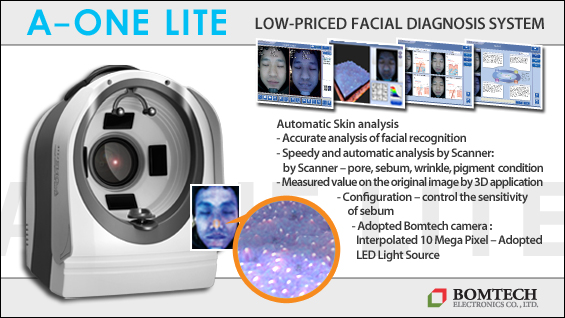▶ Previous Artlcle : #1-2. What we should know about shampoo
It would not be too far-fetched to say that everyone wants clear beautiful skin. Smooth, youthful skin is no longer the concern of only young women. Men as well as middle-aged women desire beautiful skin for a more likable appearance, better job, and a beautiful significant-other. Even middle aged men are seeking aesthetic procedures to improve their looks.
[Advertisement] A-One LITE(Facial Diagnosys System) – Manufacturer: BOMTECH(www.bomtech.net)
Clear and beautiful skin is largely determined by the skin color and tone. The skin thickness and moisture content may also affect the clear appearance. The most important factor that determines the skin tone is melanin. Melanin is produced by melanocytes. When the skin is exposed to sun light, these specialized cells produce more melanin to protect the skin from ultraviolet rays. Factors other than melanin also affect the skin tone. Hemoglobin in blood cells or carotene, a type of vitamin A, etc. are also involved in skin coloration.
Melasma is one of the most common pigment lesions involving heavier pigmentation and darkened skin tone. The skin loses its bright, healthy tone due to pigmentation from inflammation, aging, freckles, nevus, contact allergy from cosmetic products, and other pigment problems with unknown causes. These pigmentary lesions are treated with laser, chemical peeling, or oral medication, etc. but the outcome often falls short of being satisfactory.
A whitening agent is used as an adjunct or in a conservative therapy. A whitening agent is contained in a medical topical ointment or cosmetic products. The cosmetics industry in particular is paying close attention to whitening agents as the market demand for whitening effect is increasing.
When pigmentary lesions cannot be satisfactorily treated by a whitening agent alone, camouflage can bring additional benefit. Dermablend of France, Covermark/CM Beauty of Holland, and Cover FX of Canada are some of the most popular camouflage products in the market.
Substances used in a whitening agent disturb part of the melanin production of melanocytes or inhibits melanosome maturation. They also block transfer to keratinocytes or promote differentiation of keratinocytes to bring the whitening effect.
Substances inhibiting the tyrosinase, which act in the process of melanin production from tyrosine, include hydroquinone, mequinol, azelaic acid, arbutin, deoxyarbutin, Kojic acid, aleocin, glabridin, liquiritin, N-acetyl glucosamine, licorice extract, rucinol, resveratrol, 4-hydroxyanisole, and 2,5-dimethyl-4-hydroxy-3(2H)-furanone, etc.
Effect of whitening agents
Hydroquinone is the most prominent tyrosinase inhibitor that is effectively used for the treatment of hyperpigmentation. Concerns were raised regarding its safety, however, hydroquinone is usually regarded as safe at the concentration of 5% or less. Azelaic acid is a topical whitening agent that can be used in patients in whom hydroquinone is contraindicated. Although arbutin and deoxyarbutin still require additional investigation, they are currently used in tyrosinase inhibition.
Retinoid, other well-known whitening agent, promotes differentiation of keratinocytes and inhibits tyrosinase. It treats pigmentation through rearranging pigments within keratinocytes but has the major disadvantage of causing skin irritation. In order to see a brightening effect with a retinoid-only agent, it should be applied over the skin for about a month. If the patient’s skin is irritated by tretinoin, one of retinoids, adapalene can be used as an alternative. The basis of this is found in a study comparing outcomes of adapalene 0.1% and tretinoin 0.05% administered for three months in Asian melasma which reported that the difference in effect was marginal but adapalene 0.1% caused less side effects compared to tretinoin 0.05%. The combination of hydroquinone, retinoid and steroid may be much higher effective than a retinoid-only agent. One of the earliest and best-known such attempts was Kligman-Willis formula which contains 5% hydroquinone 0.1% tretinoin, and 0.1% dexamethansone. 10% hydroquinone has excellent brightening effect but can cause irritation. 0.2% tretinoin does not bring superior whitening effect but causes severe irritation and 0.05% tretinoin may be less irritating but the effect is decreased. Kligman-Willis formula was created considering these aspects.
In Korea, Kligman-Willis formula is available in two products; Triluma Cream of Galderma Korea and Melanon of Dong-A Pharmaceuticals. Triluma consists of 0.01% fluocinolone acetonide, 4% hydroquinone, and 0.05% tretinoin and Melanon contains 5% hydroquinone, 0.03% tretinoind, and 1% hydrocortisone. Using a combination of sun screen with 4% hydroquinone may bring comparable whitening effects as these products.
Retinoid and soybean trypsin inhibitor deter transfer of melanosome from melanocytes to keratinocytes. Kojic acid inhibits tyrosinase and acts with copper to give whitening effect. Kojic acid may also cause skin irritation. Ascorbic acid also interacts with copper to bring whitening and antioxidative effect. Ascorbic acid deteriorates when exposed to air, however, various types of ascorbic acid with improved stability and skin permeability have been developed.
Arbutin and deoxyarbutin inhibit maturation of melanosome. Soybean trypsin inhibitor inhibits protease-activated receptor 2. Tranexamic acid inhibits plasmin. Beta carotene reduces production of alpha melanocyte stimulating hormone-induced melanin.
As mentioned earlier, the cosmetics industry is heavily invested in whitening products, conducting a lot of research and releasing various products.
Latest trends in whitening cosmetic products integrate bioengineering technology such as genetics and stem cells, etc. to cosmetic products. Excluding or minimizing harmful ingredients such as paraben is another key issue. Cosmetic manufacturers are also trying to appeal to customers’ emotions and developing products with novel ingredients. In the past, whitening cosmetic products targeted melanin but now they are also targeting skin pigments besides melanin and improving healthful glow and smoothness.
-To be continued-
▶ Next Artlcle : #2-2. Effect and types of whitening agents





















